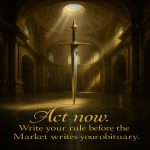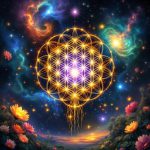
The Drumbeat of Fear
Sep 23, 2025
The Primal Shiver
Fear is older than language. Before men named gods or raised cities, they trembled. A rustle in the dark, a shadow too large, the growl of something unseen—these were enough to tighten the chest and quicken the pulse. Fear is not decoration, not weakness, not a pathology. It is the most ancient law, etched into flesh long before reason.
Hobbes recognised this with clarity that still burns. Man, he said, is wolf to man. Without a higher power, we do not fall into noble innocence, but into claw and fang. This primal shiver is not an illusion; it is the foundation upon which all order must be built. His Leviathan was not a dream of grandeur but a desperate shield against chaos. If men could live without fear, they would not need sovereigns. Fear is the bedrock, and everything else, honour, virtue, religion, is an afterthought.
The Hunger for Shelter
Homer, centuries before Hobbes, sang of the same truth, though through the mouths of heroes. Achilles, Hector, Odysseus—they fight for Glory, yes, but beneath the boast runs a deeper drive: the hunger for Survival, for their names not to be erased by dust. Their wars were clothed in myth, their fears sanctified by gods, but the core remained. Men feared death, feared dishonour, feared being forgotten. The Iliad is not only the story of wrath; it is the trembling of fragile beings who knew they could be cut down at any moment by bronze or by fate.
In this way, Homer and Hobbes are companions. One clothed fear in poetry, the other in political geometry. Both insisted that fear is no flaw to be erased, rather the relentless engine driving every human striving. The shiver drives the shield wall, the oath, the law. Without it, there is no cohesion, only scattered flesh.
Force at the Root
Here we touch Hawkins, though only at the root of his ladder. Force, in his terms, is the compulsion that makes men obey. When the soldier marches, when the subject kneels, when the mob disperses at the sight of armed guards; this is not consent, this is fear transmuted into order. It is low, crude, unstable, yet without it, nothing higher can grow. Hobbes would smile grimly at this, for he never dreamed of power without coercion. For him, the sovereign’s word carried weight only because men feared the sword behind it.
Nietzsche would later mock this dependence, calling it slavish. Dostoevsky would dramatise its corruption in the human soul. But at the beginning, here in the primal shiver, it is unavoidable. Fear binds us. Fear tames us. Fear writes the first contracts of obedience.
The cave dweller who trembled at lightning, the Achaean who quaked before Apollo’s plague, the peasant who bowed before the king’s guard—all lived by the same rule. To shiver is to survive. To ignore the shiver is to invite ruin.
The Birth of Order
Fear on its own scatters men. The lone figure who trembles at the crack of a branch does not invent order; he flees or dies. To build something larger, fear must be redirected and reshaped into a rhythm. The first order was not law, not written codes, but habit. Around the fire, men discovered the circle—a geometry older than mathematics. They sat facing one another, backs guarded, flames protecting the centre. Here was the seed of architecture: not walls of stone, but formation itself. By keeping to this pattern, they could eat in relative peace, sleep in turns, and push back the void a few hours longer. The fire did not erase fear; it made fear bearable.
Over time, habit hardened into ritual. The watch became a sacred duty, and the distribution of food was carried out according to rules enforced not by courts but by necessity. To fail in one’s role endangered all. Fear thus became collective, binding each man’s fate to that of his brother. What Hobbes later described as the covenant of self-preservation had already been lived in flesh and smoke. The circle of fire was Leviathan’s embryo, born from trembling bodies learning that Survival required discipline.
Blood and Oaths
The earliest contracts were signed not with ink but with blood. Two men cut their palms, pressed wounds together, and let their life’s warmth mingle. In that moment, they created something beyond flesh: a bond enforced by both terror and trust. Betrayal of such a covenant meant exile, and exile was slow, merciless death. Even animals turn from the diseased or abandoned. The outcast was not just rejected by men but by the earth itself.
From this primitive ritual grew the spine of civilisation. When Machiavelli, centuries later, dissected power, he wrote that fear binds more firmly than love. These tribesmen had discovered the same principle without philosophy: the fear of abandonment, of being alone in the night, outlasted affection. A man might tire of his kin, resent his leader, covet his neighbour’s kill. Still, the terror of standing alone, without circle or fire, sealed his obedience.
Homer’s heroes lived in a different age but echoed the same truth. Achilles, Hector, Odysseus—each wrapped his fears in Glory and song. They did not speak of trembling hands but of honour, lineage, and gods. Yet beneath the armour was the same blood pact: the dread of dishonour, which was another kind of exile, a living death. The Iliad is no hymn to bravery alone; it is a manual of fear refined into courage.
Discipline of Belonging
Nietzsche accused the herd of smothering greatness. Yet even in his contempt, he admitted the herd was necessary for Survival. The earliest men did not imagine the Übermensch—they clung together because separation meant annihilation. The herd was not the enemy of greatness, but its crucible. The strong man proved himself not by wandering alone but by shaping the herd’s fear into obedience.
Suvorov, centuries later, trained soldiers in this same vein. He understood that fear cannot be erased, only redirected. Soldiers who trembled before cannon fire could be taught to fear disgrace more than death. Discipline, relentless and rhythmic, transformed panic into formation. “Hard training, easy war,” Suvorov said. This was not a slogan but a law as old as the campfire: the body drilled into habit will act even as the mind screams.
Thus, the tribe discovered something larger than Survival. Through ritual, oaths, and belonging, they forged a weapon sharper than a bone spear or stone axe. Fear was no longer chaos. Fear became architecture. What began as trembling in the dark became the foundation for gods, kings, and armies—every later empire. Rome, Byzantium, and Muscovy stood upon the same principle: man’s most enduring cement is terror, not affection.
This was the first draft of the Leviathan: not yet a sovereign, not yet a lawgiver, but an invisible contract written into flesh and bone. Men learned to transform dread into duty, and in doing so, they stumbled upon the machinery of civilisation itself.
The First Tyrant
Every circle of fire casts a shadow, and in that shadow stands the one who dares to claim it. The first tyrant was not chosen, he emerged. The strongest hunter, the most ruthless killer, the one whose voice cut through fear—he stood at the centre because no one else could bear to. Men obeyed not because they loved him, but because obedience was safer than defiance. Two deaths haunted them: the predators outside and the tyrant within. The tyrant was the human face of the beast in the dark, and men preferred him because he could be bargained with. Fear of chaos gave way to fear of man, and in that transfer, power was born.
Machiavelli, centuries later, would strip this truth bare. Love, he wrote, is fragile, dissolving with fortune. Fear endures like iron. The first tyrant was proof: he did not inspire devotion, he imposed Survival. To cross him was to risk exile or execution, yet to submit was to live another day. The tyrant became Leviathan’s first skin, crude but enduring.
Myth as Chain
But strength alone cannot last. The loudest voice grows hoarse, the strongest arm weakens, and even tyrants bleed. If the rule rested only on muscle, the day of reckoning was inevitable. To survive beyond flesh, fear needed masks. Priests and storytellers entered the circle, carrying myths like chains. Thunder became judgment, famine became punishment, and betrayal became more than exile; it became a form of sacrilege. By draping power in the garments of gods, rulers extended their rule beyond their mortal bodies.
Here Dostoevsky’s insight cuts like a blade. Men fear not only death but meaninglessness. To fall into dust without purpose is a terror greater than the sword. Tyrants learned this instinctively: cloak rule in myth, and obedience becomes more than necessity. It becomes salvation. The oath breaker is no longer just a traitor to men but a rebel against eternity. Nietzsche would rage at this, declaring such myths life-denying illusions, yet he recognised their brilliance. By binding fear to metaphysics, power ceased to be temporal. It reached into the soul.
Discipline of the Sword
With gods enthroned behind kings, order hardened into empire. The oath became law, the chieftain became sovereign. Yet sovereigns learned a lesson written in blood: fear without discipline breeds revolt. Panic burns hot, but it also burns out. What was required was rhythm, the forging of fear into obedience so automatic it seemed natural.
Suvorov would perfect this centuries later in the Russian snows. He drilled soldiers until their bodies obeyed faster than their thoughts, until fear of dishonour outweighed fear of bullets. He knew that men cannot be freed from fear, but fear can be reshaped, regimented, turned into steel. Ancient rulers stumbled upon the same secret. When men marched in formation, their terror dissolved into cadence. Fear became collective strength.
Thus, the Leviathan gained flesh. It was no longer a shadow cast by fire, no longer a voice raised in terror. It was the crown, sword, and altar. The tyrant, once a man, became an institution, sustained by myth and discipline. And in this transformation, humanity bound itself more tightly than ever to its primal contract: to live together not because of love, not because of reason, but because fear—redirected, sanctified, drilled—left no other choice.
The Mask of Legitimacy
Power that relies only on terror cracks quickly. A tyrant may silence opposition for a season. Still, his death, his weakness, or his absence invites chaos back into the circle. To endure, power requires more than muscle and fear; it requires legitimacy. Legitimacy is the mask that convinces men that obedience is not only necessary but right. From the earliest shamans whispering over flames to the crowned kings of Christendom, rulers discovered that Survival rests on convincing the many that authority is not arbitrary but ordained.
Hobbes saw this with cold precision. Without legitimacy, the Leviathan becomes a monster to be slain. With it, he becomes the necessary guardian of order. Men who might otherwise resist learn to kneel willingly, for their submission feels sanctified. Dostoevsky’s figures tremble here; his murderers, prophets, and zealots live in the liminal space where authority becomes unbearable but also unavoidable. They remind us that the mask is not merely a costume, but a weight pressed upon the soul.
The Invention of Law
Law was the next evolution of the mask. Once rules were written, they seemed less like commands of a single man and more like the fabric of reality. To break them was not only to anger a ruler but to wound the entire structure of life. Written law is fear ossified, fear made permanent, fear divorced from the mortality of its enforcer. Hammurabi’s stele, Roman codes, the Byzantine corpus; each was a monument to the idea that obedience must outlive the tyrant.
Machiavelli would have admired the cunning. Law makes power appear impartial, and impartiality is more terrifying than whim. A capricious tyrant can be avoided, manipulated, or assassinated. However, a system of law is faceless and inescapable. It binds even the ruler, or at least appears to. Nietzsche, in turn, would have scorned it as the triumph of the herd: the imposition of uniformity, the flattening of difference. Yet even he could not deny its effectiveness. The law creates habit, and habit is obedience without thought.
Ritual and Submission
Legitimacy, once codified, demanded ritual. Men were not content to obey in silence; they required gestures to anchor their submission. Kneeling, bowing, and kissing the hand of the sovereign all reinforced the bond between ruler and ruled. Ritual is repetition elevated into theology. It reminds men daily that their lives are not their own.
Here, Suvorov’s discipline echoes again. He understood that soldiers must drill until ritual replaces hesitation. Authority is not argued, it is enacted. A soldier who salutes without thought is the same man who will march into fire without breaking formation. Ritual shapes the body first, then the mind. Dostoevsky’s vision darkens the picture: ritual does not eliminate conscience, it buries it. His characters choke under the weight of forms they cannot fully believe in, yet cannot cast aside.
By the time kings crowned themselves with divine approval, legitimacy was complete. Men obeyed not only because they feared punishment but because disobedience felt unnatural, sacrilegious, unthinkable. The Leviathan was no longer crude terror; it was an institution draped in law, ritual, and faith. Fear had been perfected into permanence.
The Birth of Rebellion
Yet every mask invites suspicion. The same ritual that cements obedience can also awaken doubt. If authority rests on divine sanction, what happens when the gods fail to deliver? A drought, a plague, a defeat in battle—these cracks in the order whisper that perhaps the ruler is not chosen, maybe the covenant is broken. Here, Rebellion is born, not from abstract ideals but from hunger, grief, and broken promises.
Homer’s epics contain this tension. Agamemnon commands as king, yet Achilles withdraws, enraged by insult, testing the limits of obedience. The Greek camp begins to fracture, for what holds them together is fragile: the balance between fear of defeat and the lure of Glory. Dostoevsky understood this fracture in the soul. His characters revolt not only against tyrants but against God Himself, demanding justice in a world that offers only suffering. Rebellion is less a political act than an existential one, a cry against the weight of necessity.
The Calculus of Fear
Machiavelli enters here with his cold arithmetic. To govern, he argued, a ruler must balance fear and hatred. Fear sustains obedience, but hatred breeds conspiracies. The most skilled prince terrifies without becoming intolerable. The primitive tyrant, leaning only on brute force, often collapses beneath this calculation. History is littered with the corpses of rulers who mismeasured the threshold.
Nietzsche, however, mocks this balancing act. For him, Rebellion is not merely the revolt of the oppressed but the necessary eruption of vitality. He saw in Rebellion the chance for new values to be forged, for strength to rise against stagnation. Where Machiavelli calculated, Nietzsche demanded rupture. To him, fear that paralyses is sickness, but fear that ignites Rebellion is the first step toward greatness.
Discipline and Crackdown
Suvorov offers the counterpoint. He would not deny the inevitability of Rebellion but insisted it could be crushed through preparation. Drill, loyalty, and shared hardship; these forge men who are less likely to fracture under pressure. A commander who lived in the same mud as his soldiers inspired a loyalty deeper than fear alone. The same principle applied to rulers who shared in the burdens of their people. If legitimacy faltered, solidarity could still hold.
Yet even Suvorov knew that crackdowns come. Once Rebellion erupts, rulers must act decisively. Hesitation invites chaos. A swift and merciless response may restore order, though at a terrible cost. Dostoevsky’s writings reveal the other side: the price is not only bodies but souls. Repression leaves scars in the conscience that no law can erase. Men obey outwardly, yet inwardly they rot, carrying the poison of silent rage.
Thus, Rebellion and crackdown become part of the cycle of fear. Each feeds the other. Fear births order, order births rebellion, Rebellion restores fear. The Leviathan does not break; it coils tighter, adapting, surviving, consuming revolt to strengthen its grip. Humanity’s pact with fear is never dissolved, only renegotiated in blood.
The Shadow in the Marketplace
Every marketplace carries a shadow, a dense residue of fear, envy, and suppressed greed that shapes outcomes as much as visible forces. Prices move not only in response to supply and demand, but also to whispers of panic, subtle shifts in mood, and half-buried collective anxieties. Traders often speak of “market makers” or “smart money” pulling strings, but the deeper puppet master is this shadow. It feeds on doubt, thrives on herd panic, and exerts a gravitational pull toward extremes. Unlike fundamentals, which are slow and measurable, this shadow is fluid and contagious. Once released, it sweeps across charts and screens like wildfire, pulling even rational actors into its orbit. The shadow is not external; it is born from the unresolved impulses of participants themselves, magnified by scale and repetition.
The shadow finds its clearest expression in bubbles and crashes. When prices rise without a clear anchor, participants tell themselves a story of endless ascent, a narrative woven from denial. Each new buyer pushes aside doubt, drawing confidence from the crowd, while ignoring the growing weight of fragility beneath their feet. Then, when the turn comes, that same energy reverses, cascading into a spiral of forced selling, margin calls, and desperate exits. The collapse is never purely economic; it is a psychological implosion where belief unravels. The shadow ensures that corrections overshoot, fear lingers long after rational balance returns, and markets scar participants who carry the trauma into future trades.
The old thinkers understood the shadow before markets even existed in their modern form. They saw how crowds could be swept into delirium, wars sparked by rumour, or cities gripped by superstition. These same forces, refracted through screens and algorithms, still shape markets today. What was once gossip in the square is now sentiment trending on financial feeds. The underlying structure does not change: humans amplify fear and hope until they distort reality. The shadow thrives in this distortion, invisible yet palpable, like pressure before a storm.
To recognise the shadow is not to defeat it but to coexist with it. The shadow cannot be exorcised; it is woven into the fabric of collective mood. The task of the trader or observer is to see its outlines, to sense its weight, and to avoid mistaking it for fundamentals. A rising tide of optimism may mask structural weaknesses, just as despair can conceal opportunities. The shadow does not lie, but it does mislead; it reveals the energy of the crowd without the clarity of truth. Those who mistake its roar for certainty are the first swallowed when it shifts direction.
Thus, the shadow in the marketplace is both enemy and teacher. It exposes the limits of rational analysis and forces humility. Charts may map price, reports may quantify earnings, but neither can chart fear’s acceleration once panic takes hold. Only by listening to the undertow, by watching the tremors beneath visible action, can one avoid drowning. The shadow is relentless, but for those who respect its power, it becomes a guide to where extremes are forming and where balance will eventually return.
The Dance of Greed and Fear
If the shadow is the hidden force, greed and fear are its most visible dancers. They alternate like partners in an endless waltz, each driving prices farther than fundamentals justify. Markets rarely move in straight lines; they sway, surge, and collapse because these two emotions never balance for long. Greed stretches valuations to fantasy, while fear slams them into despair. Every trader knows this rhythm, though few escape its pull. To deny it is to fall into it unthinkingly.
Greed in the market is not simply the hunger for gain; it is an intoxication. Rising prices generate a feedback loop where each new high validates the last, convincing participants that this time is different. People borrow against future gains, dismiss sceptics as cynics, and elevate momentum into dogma. Greed disguises itself as confidence, strategy, or innovation. The dot-com bubble was built on such narratives, just as the crypto mania rode waves of “new paradigm” talk. Yet beneath every euphoric ascent lies fragility: leverage stretched thin, valuations unmoored, and risk conveniently ignored.
Fear is greed’s twin, equally powerful but opposite in direction. Once triggered, it spreads faster than greed because survival instincts amplify it. Traders sell not only to limit losses but also because they anticipate deeper losses ahead. Selling begets selling, and liquidity vanishes just when it is most needed. The speed of collapse often dwarfs the climb because fear compresses time. Where greed builds over months or years, fear unravels it in days. The Great Crash of 1929, the subprime mortgage meltdown of 2008, and numerous smaller panics demonstrate how quickly confidence can evaporate once fear gains momentum.
The dance is not random. It follows a structure: expansion, peak, reversal, collapse, recovery. Greed dominates expansion and peak, while fear rules reversal and collapse; both negotiate the fragile path of recovery. Markets are not machines; they are theatres where these emotions play out in cycles, each time with new costumes but the same script. The wisdom of cycles lies in recognising where the dancers are on the floor. To mistake greed for sustainable growth or fear for permanent decline is to miss the choreography.
Greed and fear cannot be eliminated. Attempts to regulate them out of existence fail because they are human constants. What can change is awareness. Those who can step back, who can sense when the music grows frantic, can avoid joining the most destructive parts of the dance. Awareness does not prevent loss entirely, but it reduces the likelihood of self-inflicted wounds. The market punishes those who confuse emotion with truth, but it rewards those who can read emotion as a signal.
In the end, greed and fear are not flaws in the market but its pulse. Without them, there would be no volatility, no opportunity, no drama worth observing. They turn markets from dry equations into living theatres of risk and reward. To trade or invest is to enter the dance hall, knowing that at any moment the music may shift, the partners may change, and the floor may collapse. The only choice is whether to move blindly with the crowd or to dance with eyes open.
The Illusion of Control
Men hate uncertainty more than pain. Pain can be endured, rationalised, even sanctified, but uncertainty gnaws without form. It leaves the mind restless, imagining threats larger than reality. Out of this torment arises the illusion of control: the belief that if one gathers enough data, builds the right models, or follows the right rituals, the future can be shaped into what one wants. Markets thrive on this illusion, feeding participants the sense that risk is manageable, even predictable, if only they are clever enough.
The truth is harsher. Every chart, ratio, and algorithm is a torch in a storm: it illuminates a small circle, while the darkness beyond stretches infinite. Traders and investors cling to models as if they were maps, forgetting that models are abstractions, not terrain. Risk managers write formulas for “value at risk,” but when panic erupts, those neat distributions collapse. In 2008, banks that believed they had engineered risk away through derivatives discovered that they had, in fact, magnified it. The illusion of control led them to be reckless.
The human craving for control is not limited to finance. Ancient rulers read omens in stars, generals trusted entrails, and farmers prayed for rain. Each act, rational or superstitious, was an attempt to impose order on chaos. The market is a modern oracle, producing its own rituals: technical indicators, fundamental screens, and machine learning forecasts. Some tools sharpen awareness, but none eliminate uncertainty. The very act of believing they can is dangerous because it blinds participants to the limits of foresight.
This illusion extends into psychology. Investors believe they can control their own behaviour, that discipline alone can resist greed or fear. Yet experiments show that willpower is fragile under pressure. Losses cloud judgment, gains inflate it, and emotion overwhelms reason. The trader who swears to “stick to the plan” often abandons it the moment reality deviates. Control here is less about mastery than about humility: knowing the triggers, knowing when one is vulnerable, and creating structures that acknowledge weakness.
But why cling to control at all if it is so fragile? Because without it, chaos becomes unbearable. Humans need narratives of mastery, even if they are false, to function effectively. A commander who admits the battle is unknowable cannot rally soldiers. An investor who admits the market is chaotic cannot hold a portfolio. Control, even when illusory, gives enough structure for action. The danger lies not in using the illusion but in mistaking it for truth.
The challenge is balance. One must use tools and models without worshipping them, build strategies while knowing they can break, and act decisively while accepting that outcomes will often surprise. The greatest strength lies not in control itself, but in adaptability —the capacity to pivot when the storm shifts. Those who mistake control for certainty are broken when the ground gives way. Those who know it is an illusion bend without snapping.
The illusion of control will never disappear; it is woven into human nature. But awareness of its fragility can transform it from a trap into a lens. To see that control is partial, conditional, fleeting, that is not despair but freedom. It frees the trader from worshipping false idols. It prepares him to face the market as it is: vast, unruly, and indifferent. Control may be a mirage, but even mirages can guide the thirsty if they know they are chasing reflections.
The Mask of Deception
The market does not reward truth; it rewards conviction, and conviction can be manufactured. Here lies the mask of deception: appearances treated as substance, signals mistaken for essence. A company posts earnings, and before the ink dries, narratives flood the channels. Bulls trumpet hidden growth, bears whisper Decay, each sculpting perception to bend reality. What is believed, not what is, moves the price.
This dynamic is not new. Ancient generals spread rumours before battles, letting fear dissolve enemy ranks before swords clashed. Suvorov excelled at this, using misdirection and speed to deceive armies into seeing what was not there. Markets are no different. Short sellers release damning reports, hedge funds float rumours of acquisitions, influencers amplify whispers until they ring like truth. By the time facts emerge, the price has already run its course.
But deception cuts deeper than manipulation. The most dangerous lies are those we tell ourselves. Investors often deceive themselves about their tolerance for risk, the clarity of their judgment, and the certainty of their models. Nietzsche warned that man cannot live without illusion; he creates values, myths, and meanings to keep existence bearable. In markets, these illusions take the form of narratives—”tech always grows,” “real estate never falls,” “this time is different.” Each deception provides temporary comfort, then shatters with violence when reality breaks through.
Why are self-deceptions so enduring? Because they transform fear into hope. Admitting ignorance is terrifying; believing in a story, however fragile, grants the courage to act. The deception is not always deliberate; it is often unconscious, a defence mechanism of the mind against paralysis. Traders construct explanations after the fact, stitching chaos into pattern, convincing themselves they foresaw what they merely survived. This retroactive clarity becomes tomorrow’s confidence, until the cycle repeats.
Yet deception is not only poison; it is also fuel. A society cannot function without shared fictions: money has value because we believe it, laws hold because we obey them, markets exist because participants accept their theatre. Dostoevsky understood this double edge: lies degrade, but they also sustain. Man cannot live by truth alone. Too much truth would annihilate action.
The challenge, then, is not to banish deception; it cannot be done, but to see through it without collapsing. To recognise masks while still playing the game. The wise do not believe every story, yet they use stories as tools. They know rumours can be ridden like waves, narratives can be front-run, and illusions can be turned against those who cling too tightly to them.
Deception is the market’s bloodstream. To deny it is to misunderstand the organism. The task is not purity, but discernment: which lies give structure, which destroy, and which can be weaponised. Those who fail at this drown in mirages. Those who succeed do not mistake the mask for the face.
The Silent Core
Strip fear, strip ambition, strip deception; what remains? Beneath the turbulence lies a silence that few reach, because it terrifies as much as it frees. This is the silent core: the state where man confronts himself without mask or shield, without the consolations of narrative or control. Most avoid it. They drown themselves in noise, in trading screens, in the ceaseless hum of commentary. To be still in the face of chaos feels unbearable.
Yet stillness is not surrender. It is recognition. Markets rise and fall, nations fracture and mend, empires roar and crumble, but the silent core remains. Dostoevsky’s characters, broken and stripped of illusions, often reach this point in prison cells, in moments of disgrace, in the aftermath of violent collapse. Nietzsche touched on it when he spoke of becoming one’s true self. Suvorov brushed against it in his insistence that speed and clarity, not brute force, win wars. The silent core is not absence but essence: a furnace where fear burns down into raw will.
The market, in its manic cycles, teaches this by force. The speculator who loses everything and survives discovers a kind of freedom: there is nothing left to fear. When ruin is tasted and endured, the illusions of control and invincibility dissolve, leaving only presence. This is where power, not force, is born, not in wealth, not in domination, but in the refusal to be broken by uncertainty.
From this core, a new posture emerges. The trader no longer clings to models as lifeboats, nor to narratives as shields. He uses them, but does not bow to them. He recognises deception, but does not rage against it. He senses fear, but does not flee. He acts with a calm that unsettles those still lost in the storm, because his decisions arise not from noise but from silence.
This silent core is rare. Most will never touch it. But those who do find that markets, like life itself, lose their terror. They remain dangerous, but no longer absolute. And from this silence, Chapter 2 will begin, not with fear, but with the question of what man builds once fear has been mastered.










